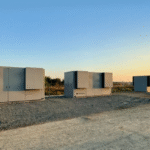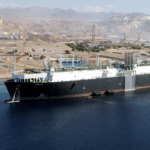Energy News Beat
Efforts to bring the fire-stricken Morning Midas under control are facing a significant delay, with salvage teams not expected to reach the drifting vessel until Monday, nearly a full week after the crew abandoned ship.
Zodiac Maritime, the manager of the Panama-flagged car carrier, confirmed that it has appointed Florida-based Resolve Marine to lead the salvage and firefighting response. However, due to the remote location of the incident — approximately 300 miles southwest of Adak Island in the Aleutian chain — the first tug with specialists and equipment is not expected to arrive until June 9.
70 fully electric cars and 680 hybrids were among the cargo onboard the Morning Midas when it caught fire on June 3 while en route to Lázaro Cárdenas, Mexico. The crew followed emergency firefighting protocols and deployed the vessel’s suppression systems, which Zodiac Maritime says were fully operational. Despite these efforts, the intensity of the blaze forced the crew to abandon ship for their own safety.
All crewmembers successfully evacuated using lifeboats and were rescued without injury by the nearby COSCO Hellas, a containership responding to the distress alert received by the US Coast Guard.
“The ability to monitor other onboard conditions is limited,” Zodiac said, noting that while the Morning Midas remains afloat and trackable via satellite, the fire remains active. A Coast Guard aerial inspection confirmed that smoke continues to rise from the vessel, though there have been no signs of marine pollution.
An additional firefighting tug with ocean towage capacity is being arranged to support the operation.
The delay in response highlights the logistical challenges of maritime incidents in remote regions like the North Pacific. Adak Island, the closest landfall, lies about 2,000 km west of Anchorage.
The cause of the fire and the condition of the cargo — particularly the onboard EVs, which have raised concerns about lithium-ion battery fires in maritime settings — remain under investigation.
Many high-profile incidents have drawn attention to the fire risks posed by lithium-ion batteries used in electric vehicles (EVs) in recent years.
The International Union of Marine Insurers (IUMI) recently called for urgent updates to safety protocols aboard car carriers, including advanced detection systems and dedicated EV firefighting strategies. Some operators, like Höegh Autoliners and Wallenius Wilhelmsen, are investing in fire-retardant deck coatings and additional thermal cameras to mitigate risks.
Shipowners and insurers alike are pressing for tighter pre-shipment checks, stricter state-of-charge limits during loading, and clearer international guidelines.
Fire and explosion incidents also saw a significant rise, with 250 reported in 2024—a 20% increase year-on-year and the highest total in a decade, according to Allianz’s recently published Safety and Shipping Review.
Lithium batteries can fail due to mechanical, chemical, or thermal abuse. This failure can lead to a phenomenon known as thermal runaway, where the heat generated becomes self-sustaining, causing temperatures to soar and triggering a dangerous chain reaction. Once thermal runaway starts, it can be almost impossible to stop, often resulting in explosions and fires.
Adding to the risk is the toxic vapour produced during battery failure. Industry sources indicate that up to 6,000 litres of vapour per kWh can be released, containing highly toxic substances like hydrogen fluoride.
A fire involving an electric vehicle might require 136,000 litres of water over four hours to extinguish, compared to just 10,000 to 17,000 litres over 30 minutes for a traditional combustion engine vehicle.
The post Salvors unable to reach fire-stricken Morning Midas until Monday appeared first on Energy News Beat.









